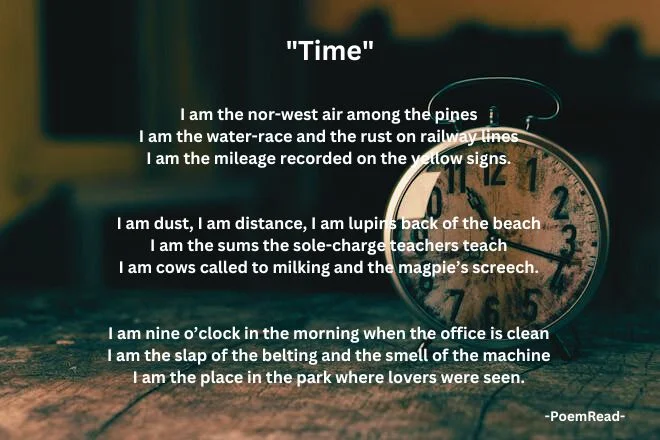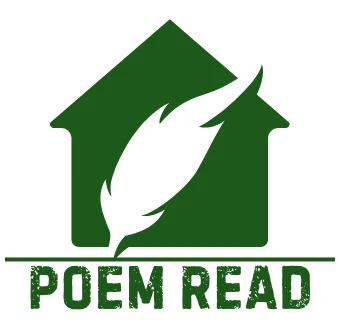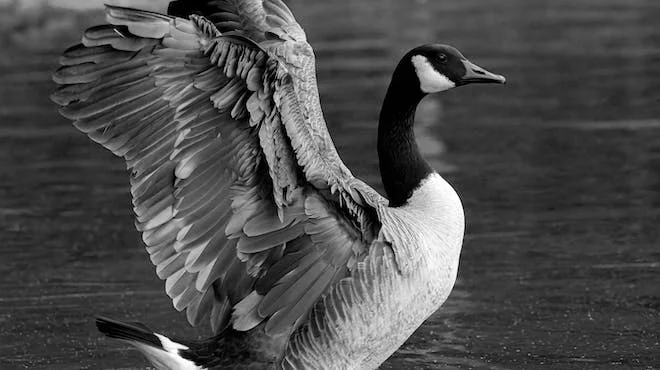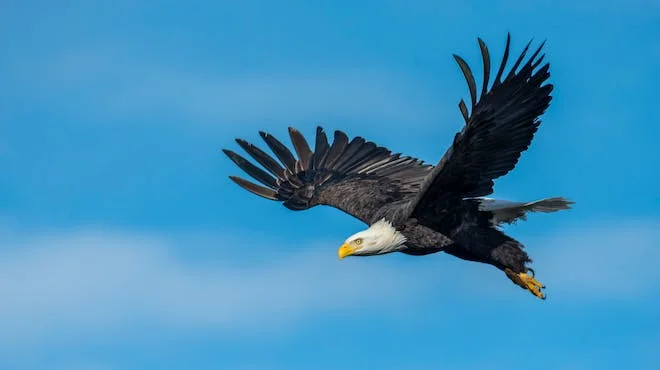
About the Poem “Time” by Allen Curnow
In this article, we explore Allen Curnow’s captivating poem “Time,” where he brings the abstract idea of time to life through vivid imagery and deep insights. As a celebrated figure in New Zealand’s literary world, Curnow encourages us to think about time’s constant presence and how it shapes not just our physical surroundings but also our thoughts and feelings. By examining the poem’s themes, imagery, and structure, we’ll uncover the rich meanings embedded in this thought-provoking piece and appreciate Curnow’s lasting contribution to our understanding of time through poetry.
"Time"
Allen Curnow
I am the nor-west air among the pines
I am the water-race and the rust on railway lines
I am the mileage recorded on the yellow signs.
I am dust, I am distance, I am lupins back of the beach
I am the sums the sole-charge teachers teach
I am cows called to milking and the magpie’s screech.
I am nine o’clock in the morning when the office is clean
I am the slap of the belting and the smell of the machine
I am the place in the park where lovers were seen.
I am recurrent music the children hear
I am level noises in the remembering ear
I am the sawmill and the passionate second gear.
I, Time, am all these, yet these exist
Among my mountainous fabrics like mist,
So do they the measurable world resist.
I, Time, call down, condense, confer
On the willing memory the shapes these were:
I, more than your conscious carrier,
Am island, am sea, am father, farm, and friend,
Though I am here all things my coming up.
I am, you have heard it, the Beginning and the End.
Content
- About the Author: Allen Curnow
- Subject of "Time" by Allen Curnow
- Context of "Time" by Allen Curnow
- Theme and Tone of “Time”
- Form and Structure of "Time" by Allen Curnow
- Line-by-Line Analysis of "Time" by Allen Curnow
- Poetic and Literary Devices Used in "Time" by Allen Curnow
- Implications and Meanings of "Time" by Allen Curnow
- Interactive Summary of "Time" by Allen Curnow
About the Author: Allen Curnow
Allen Curnow, born in 1911, was a prominent New Zealand poet. His father was an Anglican clergyman, which influenced the religious themes in some of Curnow’s early works. Initially, Curnow pursued theological studies but eventually turned away from ordination to embrace a career in writing and academia.
Curnow’s journey as a poet began with his first book of poems, “Valley of Decision,” published in 1933. His early poetry often grappled with a personal religious crisis and political and social satire. Over time, his focus shifted towards articulating a national literary character for New Zealand, exploring its history and identity through his verse.
Known for his exploration of human experiences and the landscape of his native country, Curnow’s works often reflect a deep connection to nature and a keen observation of life’s complexities. His contributions to literature have earned him recognition as one of New Zealand’s most influential poets.
Subject of “Time” by Allen Curnow
Allen Curnow’s poem “Time” is a reflection on the essence and omnipresence of time in our lives. The subject of the poem is time itself, not as a mere chronological measure but as an integral part of the fabric of existence. Curnow personifies time, giving it a voice to articulate its pervasive influence over nature, human activities, and even our memories.
The poem begins with a series of “I am” statements, where time describes itself as various elements of the natural and man-made world—from the “nor-west air among the pines” to the “rust on railway lines.” This technique not only emphasizes the constant presence of time but also its role as a silent observer of all that transpires in the world.
As the poem progresses, time discusses its involvement in everyday aspects like the measurement of distance through “the mileage recorded on the yellow signs,” as well as the presence of mundane elements such as “dust” and “distance.” These references highlight how time signifies travel, change, and the accumulation of experiences. Additionally, time is portrayed in daily routines such as “cows called to milking and the magpie’s screech,” illustrating its rhythmic presence in everyday life.
The poem then shifts to a more personal boundary. Time is present in human experiences such as work, like “nine o’clock in the morning when the office is clean”. It’s also evident in intimate moments, such as “the place in the park where lovers were seen”. In these instances, time isn’t just a backdrop but an active participant, shaping memories and evoking emotions.
Context of “Time” by Allen Curnow
The 20th century, which was a time of rapid change and growing awareness of time’s psychological effects, serves as the historical context for “Time.” The poem’s inspiration came from the sound of “some corrugated iron banging about” close to where Curnow was staying during a holiday in December 1940 at Leithfield Beach, north of Christchurch. This setting reflects the poem’s connection to the physical world and the poet’s New Zealand heritage.
In the 20th century, significant global events like wars, technological advancements, and social upheavals influenced people’s perception of time. Curnow’s poem captures this sentiment by presenting time as a force that is both constructive and destructive, a giver of life and an agent of change.
In “Time,” Curnow challenges the traditional linear view of time, instead presenting it as a complex force that interacts with the physical world, human consciousness, and memories. The poem goes beyond the usual ideas about time, exploring different perspectives that challenge what we typically think about it.
Allen Curnow’s poem “Time” prompts readers to consider the constant presence of time. He suggests that time is always with us, influencing every part of our lives. The poem leads us to think about how time shapes the world around us. It also guides us to understand how time affects our personal thoughts and feelings. Curnow’s work helps us to value the significant role that time plays in our daily experiences.
Theme and Tone of “Time”
Allen Curnow’s poem “Time” connects several themes by personifying time. The main theme is about how time is everywhere and affects everything in life. The poem shows time as always present, watching and participating in what happens in the world. It also explores how time can be both unstoppable and a way for us to grow, remember things, and gain experiences.
The tone of “time” is one of authority and confidence. Time speaks with the assurance of an omnipotent force, aware of its integral role in the universe. It is content in its existence, neither boastful nor apologetic. This tone is consistent throughout the poem, as time describes itself in various scenarios, emphasizing its all-encompassing nature.
Form and Structure of “Time” by Allen Curnow
“Time” is a twenty-one-line poem that defies traditional stanzaic form, opting instead for a block structure. This choice reflects the continuous and unbroken nature of time itself. The poem employs an unusual rhyme scheme that evolves with the progression of lines, using a pattern of AAABBBCCCDDD, and so on. This creates a sense of flow and unity, mirroring the seamless passage of time.
The use of anaphora, the repetition of “I am” at the beginning of lines, serves to reinforce the ever-present nature of time. This literary device, along with caesura—pauses within lines—adds a rhythmic quality to the poem, akin to the ticking of a clock or the heartbeat of the universe.
Punctuations
The poem “Time” by Allen Curnow is not only unique in its form and structure but also in its use of punctuation. The poem’s punctuation, or the noticeable absence of it, has a significant impact on how it is read and understood.
Curnow’s sparing use of punctuation in “Time” allows the poem to flow freely, mirroring the unending and seamless nature of time itself. The absence of commas and periods in places where one might expect them creates a sense of continuity, as if time is speaking without pause, reflecting its relentless march forward.
However, the poem does employ strategic caesurae, or pauses within lines, which serve to emphasize particular phrases and give the reader a moment to reflect on the weight of time’s words. Line breaks rather than conventional punctuation frequently indicate these pauses, which adds to the poem’s distinctive rhythm and pacing.
The use of enjambment, where one line runs into the next without a terminating punctuation mark, also contributes to the poem’s fluidity. This technique allows Curnow to maintain the poem’s momentum while also highlighting the interconnectedness of time’s various manifestations.
In summary, the form and structure of “Time,” including its distinctive approach to punctuation, are carefully crafted to match the poem’s central theme: the omnipresence and continuity of time. The poem’s structure is a reflection of its message, with each line and pause thoughtfully placed to engage the reader in a meditation on time’s enduring presence.
Line-by-Line Analysis of “Time” by Allen Curnow

First Stanza Analysis
In this opening stanza, Curnow personifies time, describing it as the gentle nor-west air among the pine trees. This imagery conveys time’s intangible and pervasive nature. The mention of water races and rust on railway lines juxtaposes natural and industrial elements, symbolizing time’s influence across different environments. The reference to mileage on yellow signs emphasizes time’s role in measuring and marking progress or journeys.
“I am the nor-west air among the pines”
Time begins its narrative as a gentle, pervasive breeze that moves through the pine trees. This image evokes a sense of calm and continuity, as the nor-west air is a common phenomenon in New Zealand, where Curnow hails from. It’s a force that shapes the landscape silently, much like time shapes our lives.
“I am the water-race and the rust on railway lines”
Here, time is both motion and stillness. The water-race, a channel for directing the flow of water, represents the ceaseless movement of time. In contrast, the rust on railway lines speaks to the inevitable decay that time brings. This line juxtaposes the constructive and destructive powers of time.
“I am the mileage recorded on the yellow signs.”
Time is also a journey, measured and quantified, as indicated by the mileage on road signs. This line suggests that time is not just an abstract concept but a tangible entity that can be recorded and observed.
Second Stanza Analysis
In the second stanza, Curnow continues to explore time’s associations with various aspects of life. Dust, distance, and lupins represent impermanence, separation, and beauty in natural settings, reflecting time’s impact on the environment. The mention of sums taught by “sole-charge teachers” connects time to education and the passing down of knowledge. References to daily farm routines like calling cows to milk and the sound of a magpie’s screech evoke rural life and the passage of time within agricultural contexts.
“I am dust, I am distance, I am lupins back of the beach”
Time is presented as dust, a fine, scattered substance that settles over everything, a metaphor for how time affects all things. The distance here can be interpreted as the expanse that time covers, both physically and metaphorically. The lupins behind the beach symbolize the growth and beauty that time allows, as well as the natural cycles of life.
“I am the sums the sole-charge teachers teach”
Education and knowledge are not immune to time’s touch. The sums taught by teachers represent the passing on of wisdom from one generation to the next, a process facilitated by time.
“I am cows called to milking and the magpie’s screech.”
Time dictates the daily rhythms of life, such as the routine of milking cows. The magpie’s screech is a sound that punctuates the day, another reminder of time’s omnipresence in the natural world.
Third Stanza Analysis
In the third stanza, Curnow mentions daily routines and human experiences. The mention of nine o’clock in the morning and a clean office setting portrays time’s structured nature and its association with work environments. Industrial imagery, such as the slap of belting and the smell of machines, emphasizes time’s presence in labor and mechanical processes. The stanza concludes with a nostalgic touch, recalling a place in the park where lovers once met. This highlights time’s role in shaping memories and personal connections.
“I am nine o’clock in the morning when the office is clean”
Personifying time as a specific moment captures a sense of potential and new beginnings. This is represented by a clean office in the morning. It’s a fresh start, a slate wiped clean by time’s passage.
“I am the slap of the belting and the smell of the machine”
The industrial imagery here reflects time’s role in work and progress. The slap of the belting and the smell of the machine are sensory experiences that convey the relentless march of industrial time.
“I am the place in the park where lovers were seen.”
Time also holds memories, as it is the backdrop against which moments of love and intimacy occur. This line suggests that time is a container for human experiences, both public and private.
Fourth Stanza Analysis
In the fourth stanza, Curnow explores auditory experiences and emotional connections to time. The recurrent music heard by children symbolizes familiarity and continuity, whereas the “level noises in the remembering ear” indicate consistent sounds stored in memory. The mention of a sawmill combines industrial imagery, symbolizing time’s presence in mechanical processes. Additionally, the reference to a passionate second gear represents the intensity of emotions associated with certain moments.
“I am recurrent music the children hear”
Time is likened to a melody that repeats itself, a comforting and familiar presence in the lives of children. This line suggests the cyclical nature of time and its role in forming lasting memories.
“I am level noises in the remembering ear”
Here, time is the background noise that lingers in our memories. It’s a constant hum that, while not always at the forefront, is ever-present and shapes our perception of the past.
“I am the sawmill and the passionate second gear”
Time encompasses both industry and emotion. The sawmill symbolizes work and progress, while the phrase “passionate second gear” evokes intense moments that leave a lasting impact on our lives. This line encapsulates the dynamic relationship between time and human experience.
Fifth Stanza Analysis
In the fifth stanza, time is portrayed as a conscious entity, revealing its all-encompassing nature. It’s depicted as part of a vast fabric, similar to mist among mountains, emphasizing its intangible but widespread impact. The mention of a measurable world resisting time’s hold suggests a paradoxical relationship between structured, measurable aspects of life. Furthermore, it represents time’s elusive, transcendent quality.
“I, Time, am all these, yet these exist”
Time asserts its omnipresence, encompassing all things yet allowing them to have their own existence. This paradox highlights the complex relationship between time and the material world.
“Among my mountainous fabrics like mist,”
Time is compared to mist among mountains, a metaphor for its intangible yet enveloping nature. It’s a force that shapes the landscape without being seen, much like time shapes our lives.
“So do they the measurable world resist.”
The poet suggests that while time encompasses all, there are aspects of life that defy measurement and quantification. This line speaks to the limitations of human understanding when faced with the vastness of time.
Sixth Stanza Analysis
Here, Curnow portrays time as an active force shaping memories and experiences. Time is depicted as calling down, condensing, and conferring shapes upon memories. The idea of a “willing memory” suggests a collaborative effort between time and individual recollection, shaping and preserving experiences.
The final line, “I, more than your conscious carrier,” suggests that time has a deep impact beyond just being acknowledged. It includes both collective history and personal stories.
“I, Time, call down, condense, confer”
Time is depicted as an active force that shapes memories and experiences. It has the power to distill the essence of moments and bestow them upon our memories.
“On the willing memory the shapes these were:”
Memories are formed by time, shaping what once existed. This line underscores time’s role in preserving the past in our minds.
“I, more than your conscious carrier,”
Time is more than just a vessel for consciousness; it is an integral part of existence, influencing and interacting with our awareness.
Seventh Stanza Analysis
In the seventh stanza of Allen Curnow’s poem “Time,” the poet uses vivid imagery and metaphors to depict the all-encompassing nature of time. By describing time as an island, sea, father, farm, and friend, Curnow illustrates time’s diverse and pervasive presence in various aspects of life.
The line “Though I am here all things my coming up” reinforces the idea that time influences the emergence and existence of all things, highlighting its role in the continuous cycle of creation and change. The stanza ends with the strong statement “I am, you have heard it, the Beginning and the End,” highlighting time’s timeless and powerful nature as both the origin and conclusion of existence.
“Am island, am sea, am father, farm, and friend,”
Time declares itself to be everything: geographical features, familial roles, livelihoods, and relationships. This line underscores the all-encompassing nature of time, touching on every aspect of life.
“Though I am here all things my coming attend;”
Everything anticipates time’s presence, highlighting its inevitability and the universal expectation of its influence.
“I am, you have heard it, the Beginning and the End.”
Time is the alpha and omega, the start and finish of all things. This line summarizes the poem’s theme of time’s omnipresence and its role as the cycle of existence.
Through these stanzas, Curnow presents a powerful and expansive view of time. He uses personification to give time a voice, allowing it to express its role in shaping the physical world, human experience, and memory. The poem’s conclusion with time as both the beginning and the end serves as a reminder of its all-encompassing nature.
Poetic and Literary Devices Used in “Time” by Allen Curnow
Personification
Curnow personifies time, giving it human qualities and a voice. This allows time to narrate its own story and express its omnipresence in various aspects of life. For example, in lines like “I am the nor-west air among the pines,” time is portrayed as if it were a living entity, capable of being present in natural elements and human activities.
Anaphora
The repetition of “I am” at the beginning of most lines is an example of anaphora. This device emphasizes the persistent and encompassing nature of time.
Imagery
The poem is rich in visual imagery that appeals to the senses and creates vivid mental pictures. For instance, phrases like “the rust on railway lines” and “lupins back of the beach” evoke specific scenes and sensations, contributing to the overall atmosphere of the poem.
Metaphor
Curnow uses metaphorical language to draw parallels between time and various tangible or familiar objects. For instance, time is compared to “the mileage recorded on the yellow signs,” highlighting its role in measuring and marking progress.
Alliteration
The repetition of consonant sounds in words like “slap of the belting” and “passionate second gear” adds a musical quality to the poem and emphasizes certain phrases for poetic effect.
Caesura
Strategic pauses within lines, known as caesurae, create a rhythm that mirrors the ticking of a clock, adding to the poem’s thematic focus on time.
Enjambment
The use of enjambment, where one line flows into the next without punctuation, contributes to the poem’s sense of continuity and the unceasing flow of time.
Symbolism
The poem employs symbols such as “the place in the park where lovers were seen” to represent moments of nostalgia and personal significance, adding layers of meaning to the narrative.
Rhyme Scheme
The poem employs a unique rhyme scheme that evolves with the progression of lines, using a pattern of AAABBBCCCDDD, and so on. This structure reflects the seamless passage of time and adds to the poem’s musical quality.
Block Form
“Time” is written in block form, which means it doesn’t adhere to traditional stanzaic structure. This form reinforces the idea of time as an unbroken, continuous force.
These devices work together to create a poem that is both a celebration and a contemplation of time. Curnow’s skillful use of language and literary techniques makes “Time” a memorable and thought-provoking piece that resonates with readers long after they’ve finished reading.
Implications and Meanings of “Time” by Allen Curnow

Allen Curnow’s poem “Time” is rich with implications and meanings that extend beyond its literal text. Here’s an exploration of some of the deeper significance within the poem:
The Inevitability of Time
The poem suggests that time is an unstoppable force that touches every aspect of life, from nature’s grandeur to our daily routines. This inevitability implies that time is a fundamental part of existence that we all must face.
The Dual Nature of Time
Curnow presents time as both constructive and destructive. It fosters growth and progress while also leading to decay and endings. This dual portrayal mirrors the complex relationship humans have with time—appreciating its benefits while lamenting its consequences.
Time as a Shaper of Memories
The poem suggests that time actively shapes our memories. It influences what we remember, condensing and conferring significance on our recollections.
Time’s Omnipresence
“Time” underscores the omnipresence of time, declaring itself as intertwined with everything, from the natural world to human connections. This universality highlights time’s integral role in the fabric of reality.
The Abstract and the Concrete
Despite being abstract, time is given concrete forms in the poem. Furthermore, this juxtaposition reminds us that even abstract concepts like time have tangible impacts on our lives.
The Humanization of Time
By personifying time, Curnow suggests a closer connection between time and humanity. It implies that time is not just a concept but a character in life’s narrative, with its own personality and agency.
The Continuum of Existence
The poem ends with time declaring itself as both the beginning and the end of everything. This cyclical perspective on life shows how existence is a continuous cycle guided by time.
Through these implications and meanings, Curnow’s “Time” invites readers to reflect on their own perceptions of time and its role in their lives. The poem serves as a poignant reminder of time’s power, presence, and paradoxes.
Interactive Summary of “Time” by Allen Curnow
In summary, “Time” by Allen Curnow is a captivating exploration of the concept of time and its significance in our lives. Through vivid imagery, a contemplative tone, and a consistent structure, the poem invites readers to reflect on the intangible nature of time and its impact on our existence. Curnow’s masterful use of poetic and literary devices enhances the overall reading experience, creating a thought-provoking and engaging piece of literature.
This interactive summary invites you to reflect on the poem’s portrayal of time as a force that is both intimate and grand, personal and universal. Curnow’s “Time” is a reminder of the constant, influential presence of time in our lives, shaping our memories, experiences, and the world around us.
If you enjoyed Allen Curnow’s “Time,” you’ll find Stephen Crane’s “A Man Said to the Universe” equally captivating. Our analysis explores Crane’s deep dive into existential themes, inviting readers to reflect on the mysteries of human existence in a poetic and thought-provoking way.
RELATED POSTS
View all



